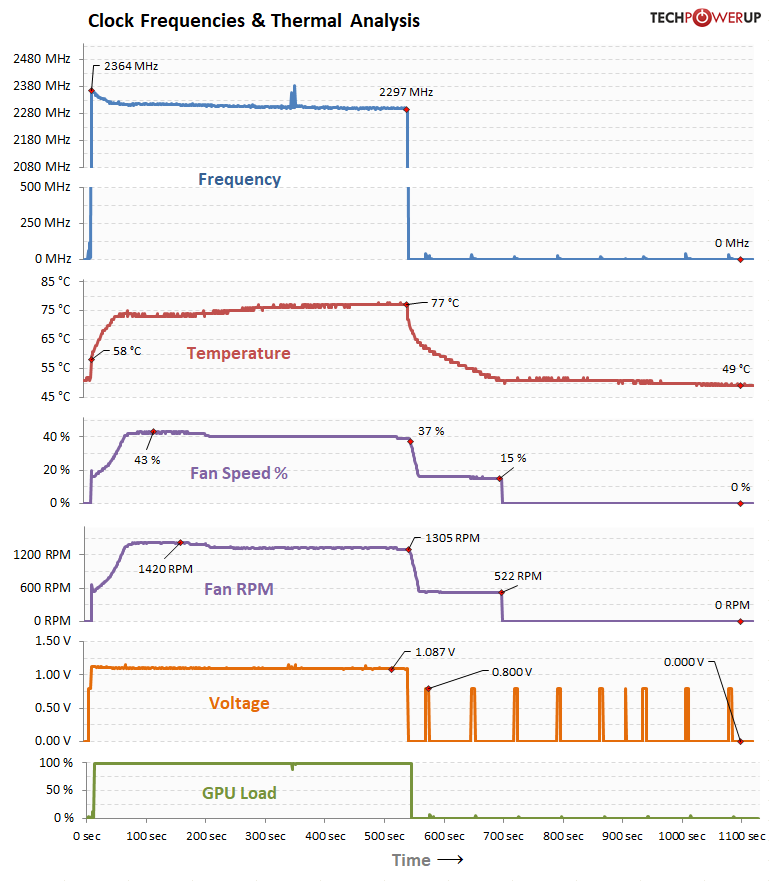 486
486
AMD Radeon RX 6800 XT Review - NVIDIA is in Trouble
Temperatures & Fan Noise »Clock Speeds
For this test, we first let the card sit in idle to reach thermal equilibrium. Next, we start a constant 100% gaming load, recording several important parameters while the test is running. This shows you the thermal behavior of the card and how the fans ramp up as temperatures increase. Once temperatures are stable (no increase for two minutes), we stop the load and record how the card cools down over time.
I also ran the same test for the Rage Mode preset:

Voltage Frequency Analysis
The card will dynamically adjust clock and voltage based on render load, temperature, and other factors.For the graph below, we recorded all GPU clock and GPU voltage combinations of our 1920x1080 resolution benchmarking suite. The plotted points are transparent, which allows them to add up to indicate more often used values. A light color means the clock/voltage combination is rarely used, and a dark color means it's active more often.

Clock Profiles
Modern graphics cards have several clock profiles that are selected to balance power draw and performance requirements.The following table lists the clock settings for important performance scenarios and the GPU voltage that is used in those states.
| GPU Clock | Memory Clock | GPU Voltage | |
|---|---|---|---|
| Desktop | 0 MHz | 4 MHz | 0.000 V |
| Multi-Monitor | 0 MHz | 6 MHz | 0.000 V |
| Media Playback | 15 MHz | 1990 MHz | 0.856 V |
| 3D Load | 1955 - 2455 MHz | 2000 MHz | 0.906 - 1.150 V |
Apr 10th, 2025 01:33 EDT
change timezone
Latest GPU Drivers
New Forum Posts
- TPU's Nostalgic Hardware Club (20210)
- Do you use Linux? (563)
- (Some of) What I'd like to See From a Final Fantasy IX Remake (9)
- Kindly help in Identifying GPU and Suitable bios (18)
- Asking before I mess up (18)
- ## [Golden Sample] RTX 5080 – 3300 MHz @ 1.020 V (Stock Curve) – Ultra-Stable & Efficient (43)
- RX 9000 series GPU Owners Club (272)
- Is the Asrock Z790M PG Lightning/D4 decent for i7 12700KF? (5)
- 5070ti overclock...what are your settings? (0)
- Will you buy a RTX 5090? (477)
Popular Reviews
- The Last Of Us Part 2 Performance Benchmark Review - 30 GPUs Compared
- MCHOSE L7 Pro Review
- ASRock Z890 Taichi OCF Review
- Sapphire Radeon RX 9070 XT Pulse Review
- PowerColor Radeon RX 9070 Hellhound Review
- Upcoming Hardware Launches 2025 (Updated Apr 2025)
- Sapphire Radeon RX 9070 XT Nitro+ Review - Beating NVIDIA
- Acer Predator GM9000 2 TB Review
- UPERFECT UStation Delta Max Review - Two Screens In One
- ASUS GeForce RTX 5080 Astral OC Review
Controversial News Posts
- NVIDIA GeForce RTX 5060 Ti 16 GB SKU Likely Launching at $499, According to Supply Chain Leak (172)
- MSI Doesn't Plan Radeon RX 9000 Series GPUs, Skips AMD RDNA 4 Generation Entirely (146)
- Microsoft Introduces Copilot for Gaming (124)
- AMD Radeon RX 9070 XT Reportedly Outperforms RTX 5080 Through Undervolting (119)
- NVIDIA Reportedly Prepares GeForce RTX 5060 and RTX 5060 Ti Unveil Tomorrow (115)
- Over 200,000 Sold Radeon RX 9070 and RX 9070 XT GPUs? AMD Says No Number was Given (100)
- Nintendo Switch 2 Launches June 5 at $449.99 with New Hardware and Games (99)
- Nintendo Confirms That Switch 2 Joy-Cons Will Not Utilize Hall Effect Stick Technology (99)